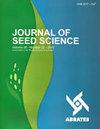经脱落酸和赤霉素处理的藜麦种子内参基因的鉴定
IF 1.2
4区 农林科学
Q3 AGRONOMY
引用次数: 0
摘要
摘要:藜麦被公认为唯一的“综合营养作物”;然而,它是易受采前发芽(PHS)。虽然定量逆转录聚合酶链反应(RT-qPCR)已被广泛用于基因表达水平检测,但选择合适的内参基因是确保在不同条件下精确定量基因表达的必要条件。本研究旨在鉴定ABA和GA作用下藜麦种子中稳定的内参基因,为后续小灵通的研究提供依据。不同浓度的ABA和GA (10 μM、50 μM、100 μM和200 μM)处理种子。根据种子活力确定最适宜的处理浓度。本文选择MON1、GAPDH、EIF3、EF1α、ACT、TUB1和TUB6作为候选基因。采用Ct值、geNorm、NormFinder、BestKeeper、Delta Ct和RefFinder等方法评估内参基因在不同条件下的适宜性。从激素实验结果来看,100 μM ABA和200 μM GA的应用效果最好。此外,不同处理最合适的内参基因是ACT和TUB1 (H2O处理),EIF3和MON1 (ABA、GA处理)以及三组组合数据集。然而,GAPDH在所有处理中表现出最低的稳定性。综上所述,ACT可作为藜麦天然萌发的内参基因,而EIF3和MON1可用于ABA和GA处理。本文章由计算机程序翻译,如有差异,请以英文原文为准。
The identification of suitable internal reference genes in quinoa seeds subjected to abscisic acid and gibberellin treatment
Abstract: Quinoa has been recognized as the sole “comprehensive nutritional crop”; however, it is susceptible to pre-harvest sprouting (PHS). While quantitative reverse transcription polymerase chain reaction (RT-qPCR) has been extensively employed for gene expression level detection, the selection of suitable reference genes is imperative to ensure precise gene expression quantification across diverse conditions. This study aims to identify stable reference genes in quinoa seeds under ABA and GA, in order to provide a basis for subsequent research on PHS. Seeds were subjected to different concentrations of ABA and GA (10 μM, 50 μM, 100 μM, and 200 μM). The most suitable treatment concentration was determined based on seed viability. Here, MON1, GAPDH, EIF3, EF1α, ACT, TUB1, and TUB6 were selected as candidate genes. The suitability of these reference genes under different conditions was assessed using various methods including Ct values, geNorm, NormFinder, BestKeeper, Delta Ct, and RefFinder. Based on the results obtained from the hormone experiments, it was observed that the application of 100 μM ABA and 200 μM GA yielded the most advantageous outcomes. Additionally, the most appropriate reference genes for different treatments are ACT and TUB1 (H2O treatment), EIF3 and MON1 (ABA, GA treatment and also for the combined data set of the three groups). However, GAPDH exhibited the least stability across all treatments. In summary, ACT is recommended as the reference gene for natural quinoa germination, while EIF3 and MON1 should be used for ABA and GA treatments.
求助全文
通过发布文献求助,成功后即可免费获取论文全文。
去求助
来源期刊

Journal of Seed Science
Agricultural and Biological Sciences-Agronomy and Crop Science
CiteScore
2.00
自引率
30.00%
发文量
28
审稿时长
12 weeks
期刊介绍:
From 2017 the Journal of Seed Science (JSS) will circulate online version only.
Original scientific studies and communications, not yet published or submitted to another journal for publication and written in Portuguese or English, will be accepted for publication. For manuscripts submitted in English, the authors should provide an adequated version.
The SCIENTIFIC COMMUNICATION is a category of scientific manuscript which describes a technique, an equipment, new species or observations and surveys of limited results. It has the same scientific rigor as the “Scientific Articles” and the same value as a publication. The classification of a manuscript as a SCIENTIFIC COMMUNICATION is based on its content and scientific merit but it can be a preliminary study, simple and not definitive on a certain subject, with publication justified by its uniqueness and contribution to the area.
The Editorial Board of the JSS may invite leading authors of recognized reputation to compose specific Review Articles covering topics of their specialization that will convey to the scientific community the state-of-the-art knowledge related to the specific theme.
 求助内容:
求助内容: 应助结果提醒方式:
应助结果提醒方式:


